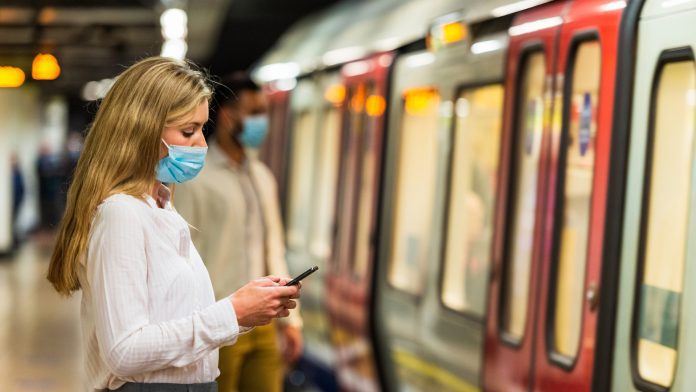
Scientists have developed an innovative computer model that has revealed people travelling on the London underground and other similar rail systems may be at low risk of catching COVID-19.
The researchers, comprised of scientists and engineers from the University of Leeds, the UK’s Defence Science and Technology Laboratory (DSTL), and the University of Manchester, designed the model to evaluate the risks of catching COVID-19 on a mass transport system for short journeys.
The computer simulations were performed before the Omicron variant arose and found that the likelihood of catching COVID-19 was mitigated through good ventilation and mitigation measures, such as face coverings, social distancing, sanitation, and urging people with symptoms to stay at home.
The model was independently developed as part of the £1.7 million TRACK project funded by the Department for Transport and the Engineering and Physical Sciences Research Council.
Professor Cath Noakes, from the University of Leeds and Principal Investigator on the study, said: “All environments where people interact together have a risk of virus transmission and public transport is no exception. Where journeys are short and not overcrowded, and the carriage is well ventilated, then the risks are likely to be quite low.
“Wearing a face covering can significantly reduce risk of the virus spreading, particularly as it can be harder to socially distance in a tube or subway carriage at certain times of the day. Even though there may be a small chance of transmission by touching a contaminated surface, this can be managed through regular hand hygiene and avoiding touching your eyes, nose and mouth. The results show that compliance with good mitigation measures is likely to be effective in reducing infection.”
The findings of the research are published in the journal Indoor Air.
Computer model findings
The team’s model simulated the risks of catching COVID-19 via the predominant modes of transmission, such as being within two metres of an infectious person, touching a contaminated surface and then touching their nose-mouth or eyes, and inhaling viral particles that linger in the air (aerosol inhalation).
The researchers said: “The risk of exposure to the virus was predicted to be low through all routes of transmission. The highest modelled doses (of the virus) were to a small proportion of people in close proximity to an infected person, which is through a combination of aerosol inhalation and direct droplet deposition.”
The findings illustrate the robust effectiveness of infection control measures, with the researchers outlining practical steps passengers and transport operators can make to reduce the transmission of COVID-19 on public transport. These include:
- When COVID-19 infection rates are high, implement strategies to reduce crowding on public transport.
- Public health policies should encourage people to stay at home if they are infectious.
- Maintain high levels of mask-wearing.
- Reduce contaminated surfaces by implementing hand sanitation facilities near high-touch points, where people get on and off trains or near escalators.
The researchers commented: “To date, there is no evidence that public transport is a major driver for the pandemic, but as a shared enclosed setting where people may be at close proximity, transmission is possible and understanding the factors that influence the likelihood of transmission is important for introducing and managing effective mitigation strategies.
“This is particularly important as public transport is a necessity for many people, and it can be an environment where social distancing is difficult to maintain, particularly in dense urban transport systems.”
Despite the recommendations to maintain mask-wearing in public places and transport, the Government in England lifted the mandatory requirement to wear face coverings in various places, including public transport. However, to reduce the chances of catching COVID-19, the Mayor of London states that face masks and coverings will remain mandatory on all London transport unless travellers are exempt. Moreover, it is still a legal requirement to wear a face covering on public transport in Scotland, Wales, And Northern Ireland.
Dr Martin Lopez-Garcia, a mathematical modeller from the University of Leeds and co-author of the research, said: ”Measuring transmission on public transport systems is challenging. Our model provides an insight into the different factors that are likely to influence risk and should be used to effectively plan strategies that reduce the transmission of the virus.”
Dr Simon Parker, a modeller from the Defence Science and Technology Laboratory (DSTL) and co-author, said: “Building a model of virus transmission for this environment requires a detailed understanding of the unique features of public transport spaces and how people use them. The results are complex but fascinating and, we hope, valuable. They reflect the interactions between disease prevalence, passenger behaviour and the environment itself.”
Limitations of COVID-19 transmission model
A limitation of the computer model is it did not account for vaccination rates among the travelling public and was developed before the emergence of the Omicron and Delta variant. Furthermore, the model did not assess the risks of catching COVID-19 in extremely overcrowded carriages, which may occur when large portions of people return to work.
Professor Noakes believes that mitigation measures are the most effective method for limiting the chances of catching COVID-19. She said: “The Omicron variant is more transmissible and the risks of exposure in different settings, including on public transport, are not yet clear. However, the mitigations identified in the study are still likely to be effective at reducing the risk of exposure to the virus.”
Professor Charlotte Deane, Deputy Executive Chair of the EPSRC, said: “These findings demonstrate the value of developing models to assess how COVID-19 spreads and are a valuable contribution to the evidence base. They also reinforce the point that measures such as wearing face coverings, good ventilation and hand sanitation are likely to play an important role in limiting the spread of the virus.”










